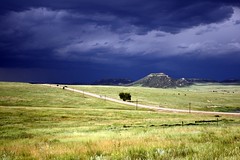 |
| Colorado Meadows (Photo credit: QualityFrog) |
Environmental Issues
How can the government impair your ability to survive?
In 2001 during the Clinton administration, the roadless rule was implemented protecting 58.5 million acres of land. The roadless rule prevented an additional road construction or maintenance on the specified land. The land consisted of national forest land as well as general US land in several states, including California, Oregon, Colorado, and New Mexico. The roadless rule was publicly supported by 4.2 million people however the Bush administration overturned this legislation. Federal judges reinstated this legislation in 2007 although this issue is still going through legal channels (Withgott & Brennan).
The roadless rule impacts many states, including Colorado. The state of Colorado has a $10 billion annual income from outdoor recreation. Colorado received $500 million in state tax revenue and 107,000 jobs are created as a result of outdoor recreational activity. This way of life supports the state’s economy. However, the roadless rule is not welcome in Colorado. According to the Denver Post, the roadless rule is not “good enough.” The rule that is geared at protecting the natural land in Colorado does not provide any long-term care of the land. Although this legislation does prevent further construction on the land, it does not provide any long-term maintenance that will ensure the current roads will be in safe condition for the use of people attending recreational events and activities. The roadless rule also does not provide protection for communities from wildfires (Abel & Robinson).
 |
| Colorado Sky (Photo credit: Let Ideas Compete) |
There are pros and cons for whether this legislation remains in effect or is successfully repealed. The roadless rule prevents further building on designated land, but does not provide maintenance on existing roads on the land. This, as in the case with Colorado, can be detrimental to state revenue that is earned from recreation in these national forests. On the other hand, the roadless rule prevents companies from building more roads or buildings on this land, thus preserving the land as it currently is.
References:
Gary Harmon/Grand Junction. (2009, August 14). President sides with
environmentalists to reinstate roadless rule. Daily Sentinel. Retrieved July 18, 2010, from ProQuest Newsstand. (Document ID: 1830838501).
Mike Van Abel, & Brady Robinson. (2010, June 20). Roadless Rule Not Good
Enough. Denver Post,p. D.4. Retrieved July 18, 2010, from ProQuest Newsstand. (Document ID: 2063073791).
Publishing: San Francisco, 2009.
